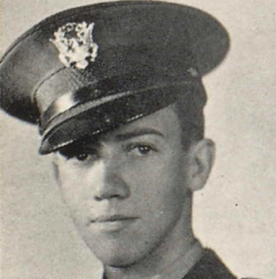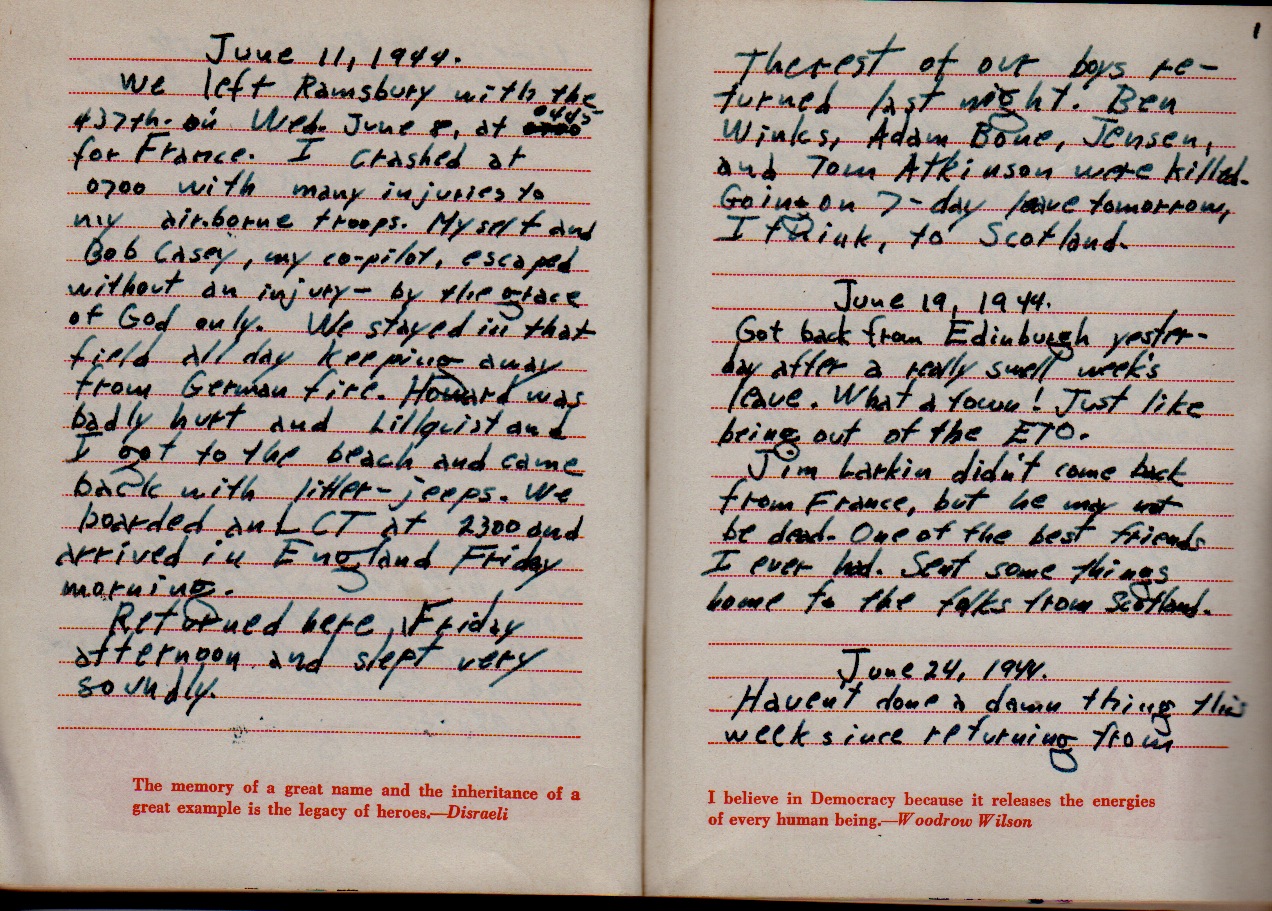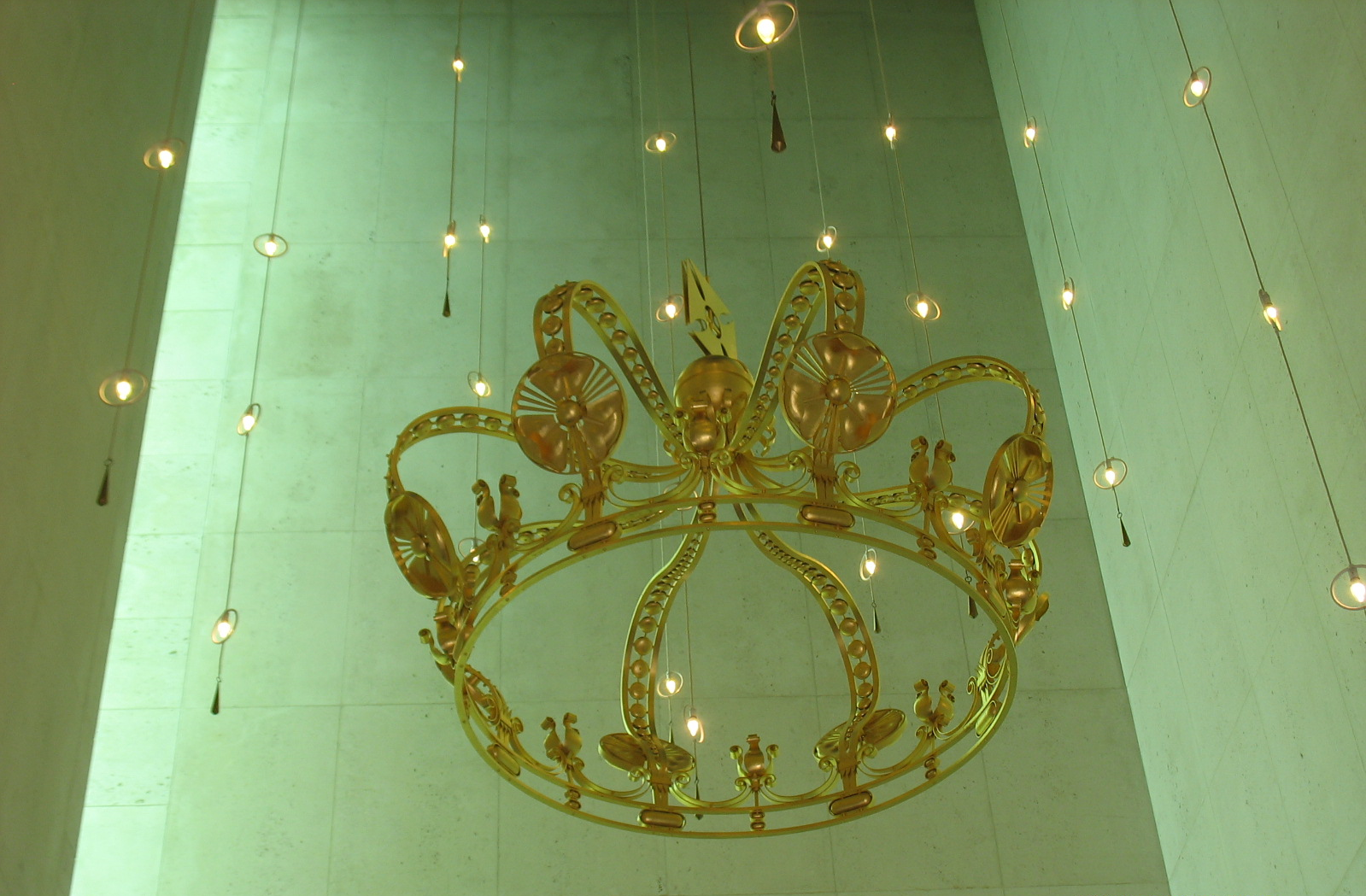Second Lieutenant Gordon Clark Chamberlain

- Unit: 82nd Squadron, 436th Troop Carrier Group
- Service Number: O-542734
- Date of Birth: March 29, 1921
- Entered the Military: June 23, 1942
- Date of Death: March 24, 1945
- Hometown: San Diego, California
- Place of Death: Rhine River, Germany
- Award(s): Purple Heart, Air Medal with 2 Oak Leaf Clusters
- Cemetery: Plot C, Row 13, Grave 13. Netherlands American Cemetery, Margraten, Netherlands
Francis Parker School
2014-2015
Early Life
Gordon Clark Chamberlain was the eldest child of a middle-class San Diego family. Gordon, his sister Barbara, and their parents enjoyed exploring the San Diego backcountry and taking driving vacations in the western states. Always interested in the military, Gordon joined the Officers’ Club of Hoover High School’s R.O.T.C. unit in October of his senior year, one month after World War II broke out in Europe.
Chamberlain attended San Diego State University in fall 1940. He served on the Associated Students publicity committee, was president of the college Toastmasters organization, and starred in a college production, The Colonel’s Lady. During the summers he worked at a local department store and became acquainted with his future wife, Eloise Jensen.
“A Job Which I Knew Held Considerable Peril…”
On December 29, 1941, Chamberlain enlisted at Fort Rosecrans, San Diego, as an aviation cadet. After 11 hours of flying, he was still unable to take a plane up on his own; he was eliminated from the program and discharged in March 1942. Three months later he tried again, this time enlisting as a glider pilot, “a job which I knew held considerable peril later on…” he wrote in his diary. Chamberlain graduated from the glider program in February 1943. He spent several more months in training in Louisville, Kentucky. In May, 1943, Eloise came to Kentucky, and they were married.


Military Experience
Gliders were new for the U.S. Army in 1942. These wooden aircraft were attached by cable to military transport planes and towed to the target. Landing infantrymen and equipment behind enemy lines, gliders had some advantages over other aircraft. They flew silently, and thus were especially effective during night landings. They could land heavy equipment, such as tanks, jeeps, and anti-aircraft guns. Gordon Chamberlain was a glider pilot in the 436th Troop Carrier Group; his job was to land troops and men ahead of the Allied armies during an operation and then to make his way back to the nearest Allied base.
In January 1944, Chamberlain traveled on the Queen Mary to England. He and his squadron began flying training missions. There were long periods when the glider pilots could not fly because of the weather. The pilots went to village pubs, played poker, and slept until noon. On one of the missions, Gordon “cracked up my glider — into two others. Didn’t get hurt, but I was lucky.” He was forced to work in the service squadron until all three gliders were repaired.
By the middle of May 1944, the pilots knew that invasion day was close. They took courses in paratroop drops and received new rifles. They went on nighttime navigation runs “about 7 miles across country.”
“Thirty hours from now we will make our drive. We hope God will be with all of us.”
The day before D-Day, Chamberlain and his fellow pilot, Casey, tossed a coin to see which one would act as pilot; Chamberlain won the toss. He wrote in his diary, “Thirty hours from now we will make our drive. We hope God will be with all of us.” Their glider took off at 4:45 a.m. for France carrying infantrymen and heavy equipment. At 7:00 a.m. they crashed in an open field. The landing knocked Chamberlain and Casey unconscious. When they awoke they found their seats twisted to face the back of the glider; the infantrymen aboard their glider thought their pilots had been killed. Gordon and Casey delivered their troops and equipment and lay in the field for hours to avoid German fire.
Chamberlain then set off for the beaches to return with a litter-jeep to collect the injured. Once back on the beach, he and Casey were assigned to guard 217 German prisoners being sent to England. Chamberlain received a Presidential Unit Citation and the Air Medal for “superb performance in initial troop carrier phases of the invasion.” In a letter to one of his professors at San Diego State University, Gordon responded to praise of his actions at Normandy by crediting the medics with extraordinary heroism. “I know of many an airborne man who would not be alive today had it not been for the tireless efforts of those [medics]…many of whom made excellent targets for German snipers.”
Chamberlain’s troop carrier group carried out other missions during 1944 and 1945. They dropped paratroopers in Holland during Operation Market Garden in September 1945. They assisted in dropping supplies to the 101st Airborne division surrounded at Bastogne. In December, Chamberlain attended navigation classes and learned about radar. “Pretty interesting!” he remarked in his diary.
Operation Varsity: the mostly costly glider mission
In February 1945, Chamberlain’s group relocated to France. It was obvious that an important airborne mission was ahead. “We draw weapons tomorrow and get our glider assignments.…I won’t worry once I can act on the ground, but I know how scared I’ll be while in the air.” Operation Varsity, the crossing of the Rhine River into Germany, included 906 gliders, the largest fleet in the war. It ended up being the most costly in terms of airborne casualties. Eighty-eight pilots lost their lives, including Gordon Chamberlain.
A San Diego State college friend, James Wallace, saw Chamberlain’s final landing site and recalled: “I saw him in the field but there wasn’t much anyone could do. He landed his load in good condition and took care of his troops.” After landing his glider, Chamberlain was killed by enemy fire.



Eulogy
In late March, 1945, Gordon Chamberlain was buried in Margraten, Holland, in the site that would become the Netherlands American Cemetery. On Memorial Day 1946, Mary Knicknie, of Maastricht, Holland, wrote to Chamberlain’s family, requesting permission to care for Chamberlain’s grave. “I beg you to send me his home address. For I think that the picture I made from his grave are [sic] great souvenirs for his family.” This program, still functioning today, is called “adopting” a grave. When Knicknie passed away, the Offermans family adopted Chamberlain’s grave. “During the war, the Germans imprisoned my father for hiding Jews,” Mr. Offerman says. “The Americans liberated him from a Nazi prison two days before he was scheduled to be executed. I show my appreciation for the sacrifice of these Americans by putting flowers on Gordon Chamberlain’s grave at least once per month.”


Reflection
Bibliography
82nd Troop Carrier Squadron; Air Force Historical Research Agency, Record Group 18; National Archives and Records Administration. Courtesy of Phillippe Evelin.
Chamberlain Family Photographs. 1925 – 1945. Courtesy of McCulley Family.
Devlin, Gerard M. Silent Wings: The Story of the Glider Pilots of World War II. London: W.H. Allen, 1985.
Esvelin, Phillippe. D Day Gliders. Les planeurs américain du Jour. Heimdal, 2001.
Fikes, Robert, Jr. Supreme Sacrifice, Extraordinary Service: Profiles of SDSU Military Alumni. San Diego: San Diego State University Library and Information Access, 2013. adminlb.imodules.com/s/997/images/FileLibrary/e3e57a3324c9477aa0f384b7f3f4a352.pdf.
“Gordon C. Chamberlain.” American Battle Monuments Commission. Accessed February 22, 2015. www.abmc.gov/search-abmc-burials-and-memorializations/detail/WWII_25874#.VcIgBp2qqko.
Gordon Clark Chamberlain Diary. 1942 – 1945. Courtesy of McCulley Family.
Gordon Clark Chamberlain to Dr. Lauren Post. 18 August 1944. Dear Doc Post: San Diego State’s Aztec Newsletter in World War II.
Gordon Clark Chamberlain, Official Military Personnel File, Department of the Army, RG 319, National Archives and Records Administration – St. Louis.
Gordon Clark Chamberlain, Individual Deceased Personnel File, Department of the Army.
Mary Knicknie to American Graves Registration Command. 29 May 1946. Gordon C. Chamberlain IDPF File, O-542734. Department of the Army.
Offermans, W. Personal interview. 24 July 2015.
Photograph; “Horsa Glider,” Department of the Army, Record Group 342; National Archives at College Park, College Park, MD.
Spencer, Major Leon G. “Eight Missions.” National World War II Glider Pilots Association. Last modified April 4, 2015. Accessed April 4, 2015. www.ww2gp.org/eight_missions.php.
Video Recording; “Horsa Gliders,” Record Group 18; National Archives at College Park, College Park, MD.
This profile was researched and created with the Understanding Sacrifice program, sponsored by the American Battle Monuments Commission.

